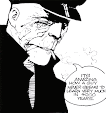Right, let's say you're working in the three-act structure and you've got an idea of what the turning points in your script are going to be: so, schematically, it looks a bit like this:

To break up that nasty gap in Act II - which could amount to an hour of screentime, add a midway turning point, to create four 'acts':

Next, you divide each of those segments in two, to create eight parts of the story.

While they won't all be exactly equal in length, they'll probably each run to 10-15 minutes for a feature-length script.
Knowing roughly the story you want to tell, you should now apply an 'emotional colour' to each of these chunks. It can be as little as one word; ambition, setback, disappointment etc.
You can then use these to take the audience with you emotionally, inserting drivers that will create a series of rises and falls in the way designers engineer a rollercoaster; they know exactly how to measure the movement to maximise the effect of the ride.
This process also keeps the characters' (and the audience's) emotional state at the front of your mind throughout. A writer needs to know how to get under the audience's skin and which buttons to press.
Having drawn that emotional roadmap, you then divide each of the eight segments into five sections, to create 40 building blocks for your script. That's now a framework into which you can drop actual events, until the story begins to lock into place.
I know it sounds very simplistic, and some people have their own issues with the notion of three-act structure, but I found this approach enormously helpful when I started Foot Soldiers, my first post-MA script.
The script is about an alienated bloke who gets sucked into a world of militant pedestrian direct action. The eight 'emotional colours' I came up with were:
- isolation/frustration
- breakthrough/connection/friendship
- belonging/inclusion/one of the gang
- sense of purpose
- loss of control
- attempt to regain control
- flight/need for survival
- confrontation/fight to the death


6 comments:
That really is very useful. Thanks for posting.
Interesting stuff and a good alternative to the "walls" notion... Nice one, Tom.
Paul Gulino's book on the sequence approach to screenwriting is a terrific resource with basically the same idea, although your visual presentation of it is beautifully simple, and the notion that you attach an emotion to each sequence I haven't seen before and yet your demonstration has prompted a 'yes, of course' moment. Good ideas love to be recognised.
I should of course give full credit to David Hanson, who gave the lecture
Sounds really useful. Think I'll try the eight sequences idea (though dividing each one up into five is a step too far for me) - but eight separate blocks sounds a whole lot more manageable than three acts!
Very interesting Tom, thanks for sharing. I may give this a shot!
Post a Comment